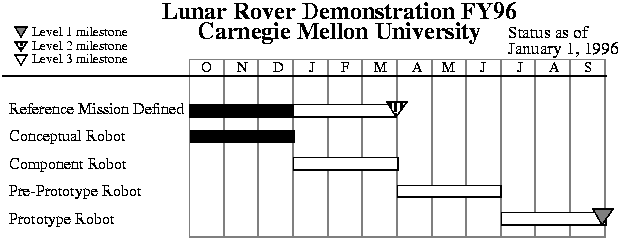Introduction
This report describes progress made during the first quarter of FY 1996
(from October 1, 1995 to January 1, 1996)
and plans for the next quarter in the
CMU Telerobotics program.
The CMU Telerobotics program consists of two tasks:
A. Significant Activities and Events During this Period
Completed "conceptual robot" (see Schedule). This involved the
following:
- Formulated terrestrial mission activities and deliverables.
- Identified potential mission sites, addressed logistical
challenges, and investigated communication options.
- Configured the electromechanism of the terrestrial robot
and began detailed design.
- Identified critical subsystem technologies, such as actuators,
processors, controllers, and proximity sensors. Computing will be VME bus
with 68000 processors.
- Investigated various options for powering the terrestrial robot,
including photovoltaics and batteries, Stirling engines, gasoline
engine generators, and migrating combustion IC engines.
- Identified torque sensor technologies with wireless telemetry
for data transfer (we have excluded strain-gage torque sensors).
- Presented the lunar rover design and subsystem technologies, and
the results of the 1000 km traverse with the Ratler vehicle
to the 2nd International Lunar Exploration Conference in San Diego, CA
- Expanded partnerships with the space industry by visiting Matra
Marconi, UK, and formulating a possible partnership in the
development of both the terrestrial and the flight lunar rovers.
Customer continued negotiations with corporations to generate a mission,
focusing on exploration, mass participation, sponsored science, and education.
This development ties in with Code X goals, and furthers the goals of
planetary exploration.
B. Plans for the Next Reporting Period
Complete "Component Robot" electromechanical design.
C. Schedule

D. Concerns/Issues
None at this time.
A. Significant Activities and Events During this Period
Prepared project schedule and detailed budget. Recruited senior
programmer and engineer.
Analyzed requirements for on-board computing system.
The two key constraints are for operation at 70 degrees C, and
compatibiity with the PCI bus.
Developed system specification meeting those requirements.
Each system uses a Pentium 133 MHz processor on the PCI bus,
fast (100 Mbps) ethernet, color framegrabbers, SCSI-2 controllers, all
running the Linux operating system.
Purchased three systems, which involved competitive bidding by
a dozen different vendors.
Performed 10 meter "dust-off" run, putting to the test new code developed
in the previous quarter
for obstacle avoidance planning and stereo vision.
Successfully avoided obstacles in indoor slag heap.
Advanced development of proximity sensor communications software,
purchased differential GPS unit for gathering ground truth data,
and evaluated new communications devices including radio-frequency modems
and video transceivers.
Implemented and validated "skyline navigation" functions for automatically
segmenting out the sky from intensity images.
B. Plans for the Next Reporting Period
Develop Pentium systems, including Linux operating system
and all device drivers. Port Unix code.
Perform indoor test runs with 4-camera stereo, proximity sensor, and
safeguarded teleoperation code running under Linux.
C. Schedule

D. Concerns/Issues
None at this time.
More information on CMU robotics
Prepared by epk@cs.cmu.edu

